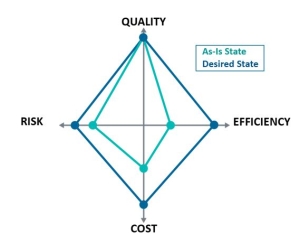Before the CW program came into existence, the way engagement managers found, vetted and procured resources was much different from today. And these managers were happier with the process and end result as well. Service levels were outstanding and time to fill could be as fast as a few days. While the engagement manager may have been satisfied, that doesn’t mean the company was compliant or keeping within budget. Hence, the creation of the CW program. There is no doubt the process has become more onerous — more details later in this article — increasing the incentive for managers to go rogue.
But there is also the prime opportunity for programs to use AI and other automated technologies that would elevate the program and make the engagement manager’s job easier all while gaining access to a better quality of workers with the right skill sets.
One such opportunity, which falls within the efficiency portion of SIA’s QECR framework, is the interviewing process. If we consider how interviews are currently managed, we see a very taxing manual effort for all involved. The candidate, manager, program office/MSP all struggle to move through the process. As a result, the process can have a direct impact on time to fill, NPS, brand integrity and overall good business outcomes to name a few.
There are some interviewing technologies which provide the manager the opportunity to create a list of specific questions which are consistent from one candidate to the next and enable the candidate to complete the interview via video, voice or text at their own leisure. This also enables the manager and/or MSP to review the interviews when they have the time.
The results will limit if not eliminate scheduling conflicts, improve efficiencies (time to fill), and reduce biased approaches as each candidate is asked the same questions in the same manner and format. This solution is not perfect, but it goes a long way to challenging status quo and helping recognize the enormous responsibilities we place on the engagement manager when sourcing contingent workers. And in the end, you may just well see your Net Promoter Scores from those managers go up.
The CW program office and the engagement managers need to understand where both sides are coming from and how they fit into the company’s mission. Ultimately, it’s not just about the dollars and cents but ensuring a user experience that that supports the program. Technology can help improve the experience for all involved, helping organization gain a competitive advantage while making it fun and easy for program users.
Process Steps Then and Now
To understand why engagement managers often chafe at CW program processes, let’s take a look at the process then versus now.
Then
The engagement managers would:
- Find suppliers on their own, while agreeing to contractual requirements, which typically were on the supplier’s paper.
- Trust the supplier has pre-screened and vetted the candidates. (Note: Because this was not centralized, there was no way to fully audit this.)
- Manage the cost of an assignment, including getting a purchase order, approving time sheets, invoicing and reconciliation.
- Manage asset requests, such as badge, cubical, phone and computer.
Now
The engagement manager starts with the basic query: Where do I go to procure my needs?
- Staff augmentation – manager goes to the VMS
- FTE – manager contacts HR and or an HRIS system
- Statement-of-work. The system used may be the VMS but can often be an independent contract tool.
But that’s just the beginning. To procure staff aug, for example, the requirements to fill a position, assuming typical non-automated programs:
- Creation of the job requirements
- Selection of resources
- Résumé screening (even if the program office or MSP is shortlisting)
- Interviewing
- Worker selection
- Offer (via VMS usually)
- Asset provisioning, onboarding
- Managing output
- Time/invoice approval
- Budget management
- Asset collection/offboarding










